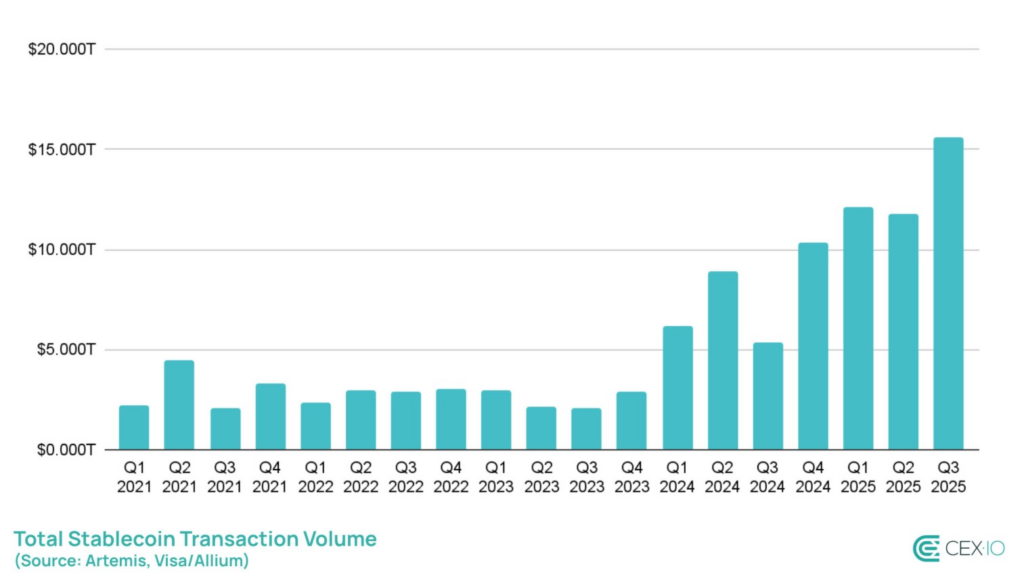Bots Fuel $15.6T Stablecoin Boom in Q3 2025 as Retail Use Hits Record Levels
Stablecoins had their busiest quarter ever in Q3 2025, with transaction volumes hitting record highs. However, a new report reveals that much of this activity came from bots rather than individual users. At the same time, small retail transfers surged to unprecedented levels, highlighting stablecoins’ dual role as a trading tool and an emerging option for everyday payments.

In brief
- Bots drove 71% of stablecoin transfers, fueling record $15.6T activity in Q3 2025.
- Non-bot transfers surged too, highlighting stablecoins’ growing role in payments.
- Retail transfers under $250 reached all-time highs, led by trading and remittances.
- USDT and USDC led stablecoin inflows, pushing market cap to $292.6B this quarter.
Over 70% of Stablecoin Transfers Tied to Bots, CEX.io Reports
Much of the third-quarter growth in stablecoin activity was driven by automated bots rather than individual users. According to new research from crypto exchange CEX.io, more than 70% of all stablecoin transfers during the quarter were tied to bots, underscoring the need to separate speculative flows from real-world adoption.
CEX.io reported that stablecoin transfers surged to a record $15.6 trillion in Q3 , marking the strongest quarter to date for the asset class. Illya Otychenko, a market research analyst at the exchange, described the period as the “most active” in the history of stablecoins.

The analysis found that automated trading bots accounted for roughly 71% of total transfers during the quarter. Non-bot transactions accounted for roughly 20%, while the remaining 9% stemmed from internal smart contract operations and intra-exchange transactions.
Regulators Weigh Systemic Risks as Stablecoin Market Surges to $292B
Otychenko emphasized that this distinction will be critical for regulators and policymakers assessing systemic risks and adoption trends. He noted that the 71% figure included both high-frequency trading bots and manipulative practices, such as wash trading. Many of these bots were “unlabeled,” processing over 1,000 transfers a month and moving more than $10 million in volume.
He added that bots designed for maximal extractable value (MEV) and those active on decentralized finance (DeFi) protocols represented less than half of total stablecoin activity .
This highlights that while bots drive liquidity and activity, a significant portion may not reflect meaningful economic usage
Illya Otychenko
Stablecoin growth has also been fueled by the recently approved GENIUS Act, which offers regulatory clarity for fiat-pegged assets. The total market capitalization of stablecoins now stands at $292.62 billion , according to recent data.
Retail Transfers Hit Record High in 2025
Despite the dominance of bots, the report highlighted a surge in retail-sized stablecoin transfers under $250. Activity in this category climbed to record levels in both September and the broader third quarter, setting 2025 on track to become the most active year ever for small-scale stablecoin usage.
The report projects retail transfers will surpass $60 billion by year’s end. Trading remains the largest driver, accounting for nearly 88% of sub-$250 transfers, but an increasing share is tied to remittances, payments, and fiat cash-outs.
CEX.io noted that non-trading retail stablecoin activity grew more than 15% this year, pointing to increasing adoption in everyday transactions. According to the platform, both trends show stablecoins are increasingly used for payments, remittances, and cashing out.
USDT and USDC Lead Quarterly Inflows
In addition to transaction activity, fiat-pegged coins also saw a sharp rise in net inflows—the difference between tokens minted and redeemed—during Q3. Data from RWA.xyz revealed that stablecoins recorded over $46 billion in net inflows for the quarter .
Tether’s USDT led with nearly $20 billion in inflows, solidifying its position as the market leader. Circle’s USDC followed with $12.3 billion, while synthetic stablecoin Ethena USDe (USDe) recorded $9 billion in new inflows.
Disclaimer: The content of this article solely reflects the author's opinion and does not represent the platform in any capacity. This article is not intended to serve as a reference for making investment decisions.
You may also like
PUMP Price Tanks 24% Amid Massive $436M Team Exit

China Reasserts Its Nationwide Digital Asset Ban as Authorities Track Rising Speculation

Nasdaq Advances Tokenized Stock Proposal as Regulatory Review Intensifies

Visa Partners with Aquanow to Expand Stablecoin Settlement Across CEMEA

